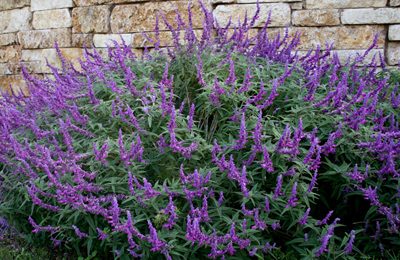Why is my native verbena dying in the middle?
Thanks to Christine Sills for her picture and great question!
All was going well with her native prairie verbena—then it started to decline. What’s going on?
Here’s what happened:
Christine added about 4 inches of top soil to her mostly clay yard. She did install a French drain in this
low spot in the garden to disperse heavy rainfall.
The plants grew all spring and summer and were covered in blooms in April and May. Then, in the
span of one week the plants suddenly and quickly turned brown, and then gray; dying from the center
outward. All of the blooms shriveled up and quickly fell off.
Christine also notes that the same thing happened last year with a prairie verbena in a different place in
her landscape.
Last year, she pruned all the dead growth as the prairie verbena was dying, and that plant has barely
come back this year.
Here’s the deal: we rely on drought tolerant plants to conserve resources. Then, we get rain bombs that
rot these drought tough plants that dislike too much water.
Christine’s situation occurred right about the time when we received several inches of rainfall in one
rain event in our area. Even though she installed a French drain, she’s still on clay soil and it’s the lowest,
water-collecting spot in the yard. So, that clay soil is going to stay too wet for many low-water plants.
How to solve it:
You can still have this beautiful native plant in your yard, with just a few adjustments. First, avoid placing
low-water plants in low spots in your yard. But if you do, you can build berms to raise them up. Be sure
to use loose, well-draining, non-clay soil, so that the plant’s roots don’t stay too wet.
Also, avoid mixing this soil with compost or other organic matter. Most drought-tolerant plants prefer
nutrient-poor soils. Soils that hold nutrients, in even small amounts, are problematic for plants that
prefer a dry, loose planting area. The plant doesn’t use the nutrients, so they serve as a food source for
soil microbes.
Combine this with wet soil, and you have a double whammy: too much water, which rots the roots,
and plenty of food for potential pathogens. So ultimately, your prairie verbena likely succumbed to
some sort of crown rot or other disease. This happens almost every year in our demonstration garden
with a similarly beautiful native plant, winecups. Like you, we prune it back to the crown and hope
that it comes back the next year, which it usually does. If yours doesn’t, consider replanting in another
location, perhaps with berms.

 Heather Ginsburg
Heather Ginsburg Daphne Richards
Daphne Richards
 Trisha Shirey
Trisha Shirey